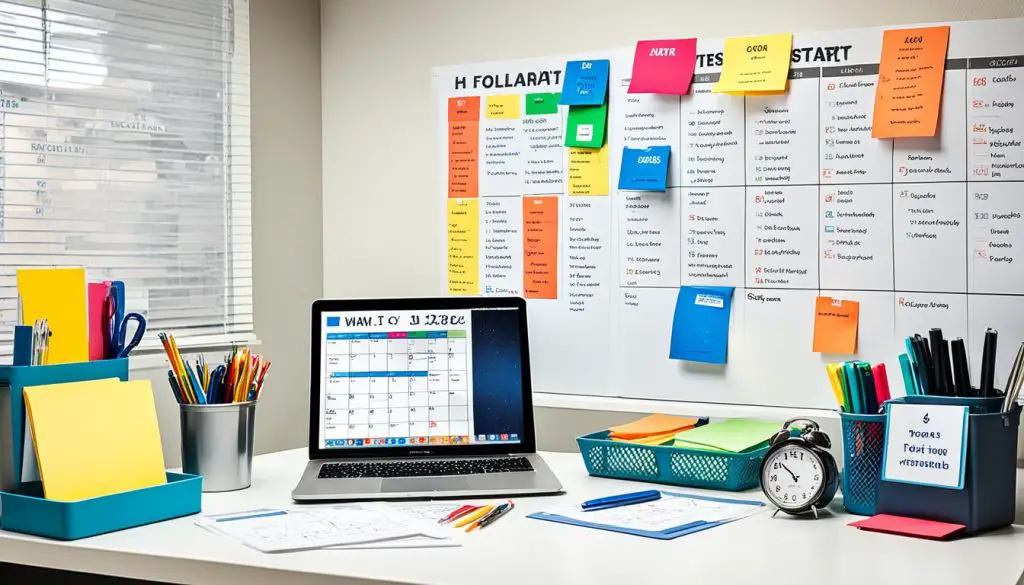My wife’s battle with chronic illness has deeply changed me. It’s shown me how tough each day can be. She juggles endometriosis and fibromyalgia symptoms, managing her energy swings. Yet, choosing to work from her home office made a big difference. It lets her work in a place that suits her unique needs. So, how can those dealing with health issues set up an office that’s helpful and organized?
How do they make sure it boosts their mood and productivity, even on tough days?
The American Academy of Pain Medicine notes that over half of Americans deal with ongoing or coming-back pain. This pain is often caused by headaches, backaches, and neck aches.1 About 40% of Americans find pain gets in the way of their happiness, daily life, sleep, work, or fun. Also, two-thirds feel it affects at least one of those areas.1 For people with chronic illnesses, this is made worse by changing symptoms, energy ups and downs, and physical limits.1 But, setting up a well-organized and cozy workspace improves productivity and mood. It cuts down stress and tiredness, too, boosting your overall health.
Understanding the Challenges of Working with Chronic Illness
Folks with chronic illness encounter unique hurdles when working from home.2 Around one in four adults might have a chronic disease. So, it’s essential for businesses to help these employees.2 Chronic symptoms, along with energy ups and downs, can mess with work plans.2 Also, lower physical abilities make setting up a home office tough.
Unpredictable Symptoms and Fluctuating Energy Levels
Life with a chronic illness means every day is different. Some days you’re on top of the world, other days not so much.2 This makes having a flexible work setup crucial. It’s all about adjusting to the moment.
Limitations on Physical Mobility and Stamina
Moreover, physical limits can affect working from home.2 These limits might include trouble moving easily or staying focused for long periods. Creating a workspace that fits these needs is key. It helps in making a more helpful work environment.
The Importance of an Organized Home Office Space
Dealing with chronic illness can be hard, but an organized home office offers big benefits. It boosts productivity and efficiency. This gets things done faster because all needed items are easy to find.3 A tidy space also cuts stress and tiredness. This is key for those with chronic illnesses.3 Plus, a setup that’s ergonomic and cozy can make us feel better. It fights the discomfort of long work hours.3
Increased Productivity and Efficiency
An organized work area means more work gets done better. Employees can quickly lay hands on what they need. This stops time from being wasted looking for stuff.4 Plus, a neat desk makes a good impression on visitors and clients.4
Reduced Stress and Fatigue
Less clutter means less stress and fatigue, which is huge for those with ongoing health issues.
Tidying up can lower stress and make a space feel more positive. It beats the bad vibe of mess and disorder.5
Staying neat helps us feel in control and deal with stress better.5
Improved Comfort and Well-being
A comfy office does wonders for our well-being and keeps us comfortable. It tackles the body aches after hours of sitting. This shows cleanliness is vital for our health.
Healthy living spaces are better for us than walking-friendly neighborhoods, studies say.5 Cleaning up also boosts our mood, creativity, sleep, and focus while reducing tiredness.
Organizing Home Office Chronic Illness
Setting up a home office for people with chronic illness needs a special plan. This plan must solve issues from changing symptoms and physical limits.1 Over half of Americans face ongoing or recurring pain, with top causes being headaches, backaches, and neck pain.1 Almost 40% say this pain affects their mood, activities, sleep, work, or joy of living. And two-thirds feel this pain affects at least one of these things.1 To tackle this, we must focus on key tasks, make work areas friendly and easy to use, and tidy up our space. We also need to build good habits, use tech for organization, and ensure our space feels calming and supportive.
Using these steps, you can make a workspace that boosts your work, comfort, and health, even with daily health challenges. This plan helps meet the unique needs of those with chronic illnesses, handling issues like surprise symptoms, changing energy, and physical limits.
It’s key to set clear goals and make a doable plan. Focus on making your workspace comfy and practical, with furniture and tools that fit your needs. Getting rid of stuff you don’t need and simplifying your space reduces stress.
Creating regular habits and to-do lists brings order and predictability. Using digital tools to organize your work and time makes things more efficient. Also, adding natural elements, soft light, and cozy touches to your space can boost your mood and work quality.
Following these detailed steps, those with chronic illness can set up a home office that meets their needs. It helps them work more easily and efficiently, despite health challenges.
Prioritizing Tasks and Creating a Plan
Organizing a home office for those with chronic illness is crucial. It involves setting priorities wisely and making a realistic plan. Identify areas that will boost productivity and happiness the most. Then, focus your energy and resources on those key changes.
This effort might include improving your workspace, removing clutter, or starting new routines. It’s also vital to set goals that are doable and choose the right times to achieve them. Remember, it’s crucial to avoid too much and allow leeway in your plans to prevent burnout.
Identifying High-Impact Areas
The heart of organizing a home office for chronic illness is to focus on what matters most. This means getting your work area, space clean, and setting up routines right.6 By doing these high-impact actions, you make the best use of your limited energy. These changes hit hard in a positive way.
Setting Realistic Goals and Timelines
It’s key to set achievable goals and times for a home office. Pushing too hard, or expecting too much, can backfire. You might end up drained and with no progress.6 Break big tasks into small, doable ones. And don’t be afraid of adjusting your timeline as needed. This keeps you moving forward while looking after yourself.
Ergonomic and Accessible Workspace Setup
Setting up an ergonomic, accessible home office is key for those dealing with ongoing health issues. It means picking flexible furniture and gear that adjusts easily. This setup reduces the risk of physical stress and helps you work more comfortably.7 For instance, an adjustable desk, a chair designed for proper support, and setting up your keyboard and screen the right way can make a big difference. They can cut down on aches and tiredness from sitting and working too long.7 Adding tools like a document holder or a desk that lets you stand can further improve your workspace. This makes it less likely you’ll get hurt from working.7 Making your workspace fit you better helps you deal with your health limits. It means you can focus on your work without as many pains.
Adjustable Furniture and Equipment
Getting furniture and gear that changes easily is vital for your health. This means an adjustable desk for height changes and an ergonomic chair to keep you sitting right. Choosing a height-adjustable computer screen and placing it right can keep you from being uncomfortable.7 If you wear bifocals, dropping the screen a bit more can make it easier to see.7
Minimizing Physical Strain
Adding more ergonomic steps can also cut down on how much your body aches.7 An under-desk footrest can ease the pressure on your legs and improve blood flow.7 Keeping needed items close stops you from overextending, meaning less arm and shoulder pain.7 A headset instead of holding the phone can stop neck and shoulder ache.7 Taking a break to move, stretch, or stand every so often can make a big difference in how you feel all day.7
Decluttering and Streamlining
Clearing out and organizing the home office boosts both productivity and mood, especially for people with chronic illness.8 Tossing aside things not needed and setting up a workspace with just the essentials cuts down on distractions. This makes it easier to concentrate and grab what you need quickly.8 You might have to rethink why you keep certain things and then let them go.8 Going minimalist not only clears the clutter but also makes your space serene and easy to navigate.8
Letting Go of Unnecessary Items
It’s key to be really critical when tidying up the home office.8 Letting go of stuff you don’t need opens up both physical and mental space, leading to a clearer and more efficient work area.8 This means going through every nook and cranny to get rid of the things that just take up space.8 Choosing only the essentials to keep around is a great way to make your work zone more calming and focused.8
Creating a Capsule Home Office
After you’ve cleaned up, it’s time to set up your capsule home office.8 Pick out your must-have office items and only keep those within arm’s reach.8 This reduces the clutter, whether it’s actual stuff or just in your mind, and helps you locate things fast.8 Plus, it’s easier to keep your workspace tidy when there’s not a lot around.8 This method is especially helpful for those with health issues. It saves energy and turns your work area into a peaceful place.8
Establishing Routines and Habits
Starting and keeping routines and habits is key for people with chronic illnesses working from home.8 They can make lists for each day and week to make sure they do what’s needed. This is important, especially on days when they feel too tired to do much. Also, using tools to automate tasks like setting up meetings or remembering things can take a huge mental weight off their shoulders. Such routines and habits bring order and help them feel more in control. This is very useful for those dealing with the ups and downs of their health.8
Daily and Weekly Checklists
Creating detailed checklists for each day and week can be a lifesaver for those with chronic diseases working from home. These lists include tasks like checking emails, managing project deadlines, and making sure they have what they need.8 This allows them to focus on small, doable tasks throughout the day. It’s great for keeping productive even when they don’t have much energy.8
Automating Tasks and Processes
Using tech to automate tasks can really help those with chronic illnesses at home. Things like scheduling appointments, reminding of upcoming events, or keeping digital files in order can all be automated.8 This can save a lot of mental effort and energy for other important tasks. By using the right apps and tools, they can keep their work well-organized. This is crucial, especially on tough days.

Embracing Digital Organization
Digital organization is key for those working from home with a chronic illness.9 It lightens the load and boosts efficiency by tidying up digital space. Important tools include task managers, note apps, and online collaboration platforms. These can make work smooth, especially on tough days.
Streamlining Online Workspace
Clearing up the digital workspace makes a huge difference. It’s about setting up a method for emails, keeping files in one place, and cutting down on apps for talking to others. This way, people with chronic illness can quickly find what they need and avoid the stress of messy digital spaces.
Utilizing Productivity Apps and Tools
Using apps and tools that boost productivity can transform a workday for someone dealing with a long-term health issue. These tools help in managing tasks, taking notes, and working on projects with others. Cloud-based platforms allow sharing of work online, making team projects easier from home.
Creating a Soothing and Nurturing Environment
Designing a home office goes beyond just being functional. You can boost your mood and how well you work by making it calming and nurturing. Adding things from nature, like plants or art, can make you feel more at peace and less stressed.10 Also, choosing the right lighting and decor, with soft lights and warm colors, helps. It makes your workspace feel relaxing and refreshing. So, people dealing with health issues can use their workspace to relax and heal, which is good for their mind and body.
Incorporating Nature and Greenery
Having nature in your workspace can really change how you feel. Live plants not only look nice but also clean the air. They reduce stress and make the place feel calm.11 Nature-themed artwork, like scenes of nature, can also help create a peaceful vibe. It can make you feel like you’re somewhere outside, away from work.
Enhancing Lighting and Ambiance
The right lights and ambiance can turn your home office into a calming space. Use soft, natural lights from windows or lamps to make it warm.11 Adding soft fabrics, like rugs or curtains, makes everything cozier. This helps everyone, but especially those with health problems, feel better and more at ease in their work area.
Enlisting Support and Assistance
Setting up a home office when you have a chronic illness means you’ll need help.3 You might ask family or hire help for tasks like cleaning or running errands. This way, you save energy for work.
It’s also smart to ask your job for special work conditions.3 They might let you work different hours or tweak your equipment. These changes can make working from home easier.3
Using the support around you can make your work environment better. It helps match your job with what you need because of your health.
Delegating Tasks to Family or Professionals
Getting family or pros to help can really help people with chronic illness work from home. You can let them handle cleaning, shopping, or other chores. This frees you to focus on your work.3
This move not only boosts how much you get done. It also makes you feel better in your home office.3
Seeking Accommodations from Employers
Working from home with chronic illness means you should see what your employer can do for you.3 They might adjust your work hours or set you up to work from home more.
It’s important to talk to your boss about what you need. They might surprise you. Getting the support you need makes work better for you and your health.
Celebrating Small Victories and Adjusting as Needed
Having a home office with a chronic illness is a journey.12 It involves noticing how far you’ve come, cheering for little wins, and tweaking your setup as things change. It’s key to see and cheer small moments, like organizing a space or starting a new daily plan. These steps can really lift your spirits and drive you forward.12 And, staying open to change in how you organize is crucial. Your symptoms, energy, and where you live might change, so your setup might need to as well.
Acknowledging Progress and Milestones
Little achievements can do wonders for your job life, making you feel good and boosting energy.12 Moving forward in your work helps keep you and your team going strong.12 Celebrating these wins is especially important for those with chronic illness. It keeps them hopeful and active, even during tough times.
Adapting to Changing Circumstances
Leaders play a big role in their team’s happiness and drive, by encouraging their growth and recognizing their hard work.12 Similarly, folks with long-term health issues should adjust their work setup as needed.12 Setbacks can hit hard, so keeping a positive outlook and solving problems is a must to overcome challenges.
Valuing growth and showing kindness to ourselves helps in maintaining an effective office at home.12 Leaders need discipline for their teams to better themselves, which is also true for those with health issues who work from home.12

Everyday office workers have experiences that light up their days, much like famous creative minds.12 This is equally true for those with chronic illness managing their home workspace.12 Doing creative work parallels well-known artists, showing even small wins can greatly improve daily happiness and work quality, regardless of health challenges.
Maintaining an Organized Home Office with Chronic Illness
Keeping a neat home office with a chronic illness means working at it all the time. The American Academy of Pain Medicine says over 50% of Americans face ongoing or repeatedly hurt. This hurts their happiness, actions, sleep, work, or joy in life. For two-thirds, pain affects at least one of these areas.1 Starting the office and keeping it organized may be hard. But, it’s crucial to set up habits and ways that last.
To keep things in order, you might need to change your work area often. This could mean making tasks automatic. It’s also about being ready to adjust when things change because of your health. Planning and being ready for what’s ahead can make sure your workspace helps you keep on being productive and happy, even as health problems develop.
Turning to digital tools, making your workspace calm, and getting help from others can help a lot. The main idea is to stay open and willing to change. Also, cheer every win and keep making small adjustments to fit the new challenges of your illness.
Source Links
- https://www.getorganizedwizard.com/blog/2017/02/managing-chronic-illness-staying-organized/
- https://www.insperity.com/blog/employees-with-chronic-illness/
- https://www.nationalgeographic.com/premium/article/organizing-clutter-mental-health
- https://woworganizing.com/benefits-of-an-organized-home-office/
- https://www.verywellmind.com/how-mental-health-and-cleaning-are-connected-5097496
- https://liveinplacedesigns.com/how-home-design-can-help-you-live-with-a-chronic-illness-or-condition/
- https://www.mayoclinic.org/healthy-lifestyle/adult-health/in-depth/office-ergonomics/art-20046169
- https://thehealthsessions.com/get-organized-with-chronic-illness/
- https://online.northeastern.edu/resources/what-is-digital-transformation-in-healthcare/
- https://www.julieannrachelle.com/blended-decor-blog/wellness-design-for-chronic-illness
- https://nourishingminimalism.com/clutter-depression-and-anxiety-a-vicious-cycle/
- https://hbr.org/2011/05/the-power-of-small-wins
